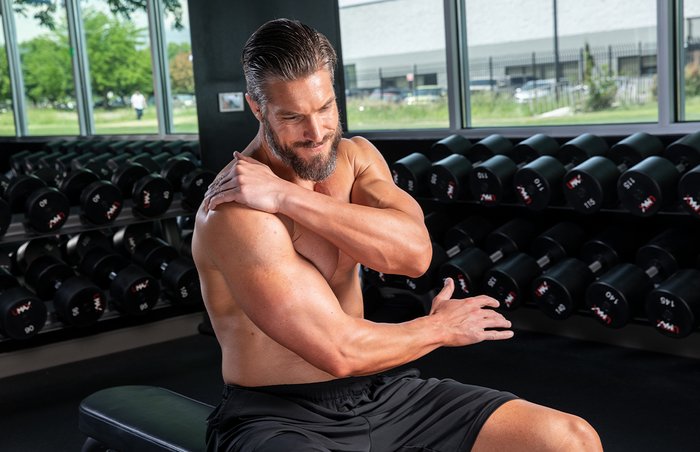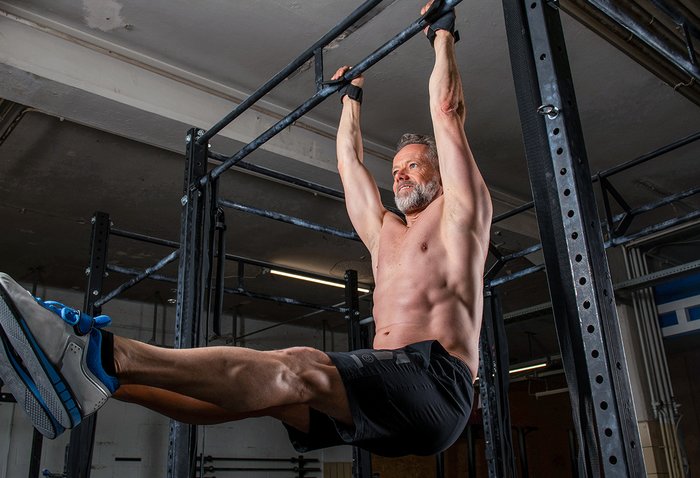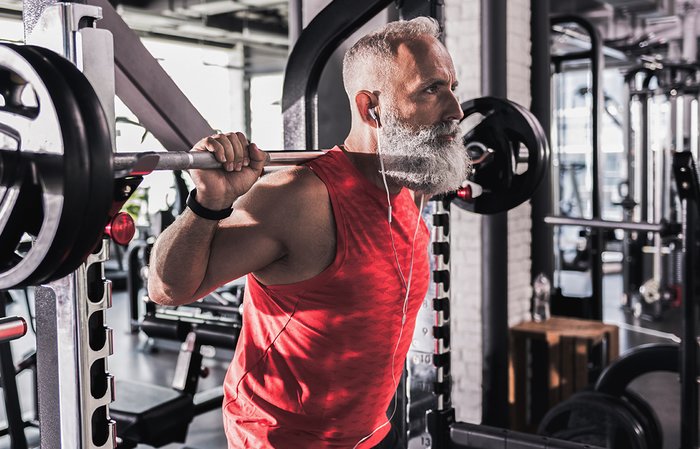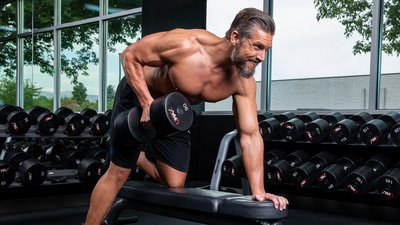As I've gotten older, I've become known by some people as "that skinny old guy who can do 10 reps with your deadlift max." But while I chuckle at that characterization, what I'm most proud of (and grateful for) is what it means in action: I'm able to continue lifting pretty heavy weights as a soon-to-be 60-year-old lifter, without most of the aches and pains you might expect from that.
Sure, every so often my shoulders get cranky, and I've got a bit of calcium in my left elbow. But that's pretty much it. My hips, knees, and back continue to play along. And part of that is what you may call "luck," but a major part of it is making conscious choices to keep me out of pain.
These seven rules are how I got here—and how I plan to stay here as long as possible. No matter if you're 40, 50, 60 or just a younger person who wants to keep lifting at those ages, pay attention.
1. Never Lift Through Pain. Ever.
This is rule number one for all older lifters dealing with chronic injury issues. Pain is your body telling you how to resolve whatever injuries you have.
Acclaimed strength coach Mike Boyle advises: "Pain that dissipates during or after your warm-up is still pain." Now, I'm sure that on an intellectual level you already understand it, but perhaps you have a difficult time squelching your more primitive instincts to keep pushing despite the pain. Maybe you reason that you're just being "weak minded" and can pop an Ibuprofen to help you sleep that night.
If so, let me introduce you to a revolutionary technique devised by lower back pain expert Dr. Stuart McGill, who has resolved many cases of severe back pain with it. It's known as "virtual surgery", and here's how McGill performs it:
When a new patient comes in with lower back pain, McGill places his palm on top of the patient's head for a moment and declares "OK you've just had virtual back surgery. So what are you going to do for the next 6-8 weeks?" Puzzled, the patient guesses hesitantly, "Rest?" "Exactly!" McGill replies. And sure enough, many lower back pain sufferers (not all, mind you) experience complete relief from their pain.
If something hurts regularly, rest it! If over a period of a week or so, you don't see at least a gradual reduction of symptoms, get yourself checked out. But no, this doesn't mean you need to simply hang out on the couch.

2. Train What's Not Injured
Every injury is both a warning and a veiled opportunity. Here's what I mean: Recently, I was experiencing some elbow pain that meant I wasn't able to do any type of loaded elbow flexion without pain, including chin-ups or curls of any kind, for approximately 10 weeks. So, I rested my elbow.
However, I could work triceps with no issues at all. So that's what I did. Sure, I temporarily lost some strength in my pulls, but it came back soon enough after my layoff. And meanwhile, my pressing exercises got stronger. Adding a little size to my triceps even meant that my arms appeared bigger.
This is the definition of a silver lining. Shed your ego, do what you can, and embrace the long road.
3. Train Your Most Problematic Exercises Last, Not First
This is a "hack" that has worked for countless lifters, but if you want to be one of them, your ego will have to take another temporary hit (sense a theme here?).
Here's why: Most lifting-related orthopedic issues are related to the exercises you do first in your workout. The bench press is a common example of this. Guys will start their upper-body session with the bench, with the rationale that they "have the most energy" early in the workout. Then, after multiple sets of intense benching, they move on to lats, shoulders, arms, etc.
The predictable result is that they end up with a strong bench and chest, as well as cranky shoulders and elbows. Here's what happens if you turn that workout around:
- By doing back, shoulder, and/or arm work first, your shoulders and elbows will be more thoroughly warmed up from less-irritating exercises before you start benching.
- At the end of your workout, you'll be less likely to fall victim to "ego lifting" since your energy levels are lower at that point and your muscles are fatigue.
Will your bench press suffer when you do it last? Maybe for a while. But your newly strengthened delts and triceps will probably catch up and maintain (and sometimes improve) your bench, despite de-emphasizing it in your training. And benching is a lot more fun when it doesn't hurt, even if your numbers take a temporary dip.

4. Increase Your Reps
Throughout my lifting career, I've been torn between two somewhat conflicting goals: I want to be stronger, but also more muscular. Traditionally, these two goals suggest different methods: heavy weight and low reps for the former, more moderate weight and higher reps for the latter.
However, in recent years, I've discovered that you can in fact lift heavy weights and do higher reps. It simply requires using a different definition of "strength" beyond a 1RM or even a 5RM. If you can lift a weight for 10 reps that's heavier than what you could handle before, that also means you're getting stronger!
In my article "How I Got in the Best Shape of My Life at Age 55," I call skipping hard sets of 10 in my youth "my primary training regret." Nearly five years later, I still feel the same way. And after putting my training focus on higher-rep sets during that time, I've seen it pay off over and over again.
I'll be honest: My 1RM on the deadlift hasn't improved since I was 50. But I'm also pain-free, leaner, more muscular, and stronger in the higher rep brackets, despite being almost 60 years old. That's a payoff that's worth it for me.
5. Pull Back After a PR
Recently, I hit an all-time 10-rep deadlift PR with 420 pounds. Getting there required me to add a "consolidation cycle" in my programing, adding weights and volume and focusing on the lift. But when it happened, I'll admit, the PR still looked—and sounded—like a battle.
After reviewing that video, I decided to spend a few weeks backing off a bit to clean up my technique before pursuing similar numbers again in the future. Here's a much better-looking set of 405x10, which I did two weeks after that death struggle with 420.
In the following weeks, I continued to push the numbers, trying my best to keep things clean. But, if and when things start to get ugly again, I'll revisit that consolidation cycle.
Touch a peak, then back off. Rinse and repeat.
6. Find Your Own "Big Lifts"
Many lifters, after seeing my videos on IG and elsewhere, write to tell me that they're inspired to start pushing their own deads to similar numbers. Reading these messages, I'm flattered, but also sometimes concerned. Not everyone can safely push deadlifts as hard as I do, and the same goes for other exercises.
You want to know why you've never seen a video of me doing crazy-heavy benches? Because I can't! Yes, I can bench safely, but I can't train the bench as aggressively as I can train pulls without my shoulder raising the white flag.
It can take a long time to find the "best exercises" for you, and the answer will vary widely among individuals. But you'll know when you've found one when you can do it with good technique on a fairly regular basis, with what feel like substantial loads, without nagging pain or injury. The deadlift might not be that lift for you, no matter how much you want it to be. But maybe the trap bar deadlift is. Maybe the Romanian deadlift is. Heck, maybe it's the belt squat.
That's one reason why my BodyFit Elite program Total-Body Strong has different versions of the major movement patterns in each workout: So you can have options, and different lifts to track as they progress.
If you can't ever seem to manage a certain exercise with acceptable form, or even if you can but you keep getting hurt, listen to your body, look for alternatives, and embrace them when you find them. Yes, it can take a while to find "your" big lift, but it's a search that you need to prioritize if you're going to make long-term progress.

7. Take Pride in More Than PRs
My friend Bret Contreras, Ph.D., has an interesting observation: We injure ourselves most often on the exercises that we really care about. As Bret often jokes, nobody cares how much weight they can use on leg curls, low-cable rows, and calf raises. And nobody gets hurt on them.
The exercises that most guys do care about? Things like bench presses, deadlifts, and squats—the moves most responsible for most injuries. The issue isn't with the exercises, but how hard we push these movements, and how ego-invested we are in them.
If that sounds like you, hey, it's normal. But it's also a reason to be especially careful with the "Big 3" or any other exercises that permit especially heavy loads—such as the leg press. As you get older, I highly recommend you try whenever possible to get your gratification not simply from how strong you are, but also—and even more importantly—things like:
- Being able to add muscle or lose fat
- Feeling good, not crushed, after your workouts
- Not injuring yourself, or being free of pain in general for extended period of time
- Seeing your strength training carry over elsewhere in your life
We all know these are good things. But most of us aren't limited by how much we know, but rather how well we apply what know. Remember: There's nothing wrong with feeling good! The more years you have under your belt, the more that will make sense.
Ready to put these rules into practice in the gym? Follow Total-Body Strong, Charles Staley's eight-week full-body strength-training program in BodyFit Elite. You'll hit every muscle group three times a week, with the perfect blend of intensity and variety. This is how to train for lifelong gains!

